Budget Micro-ATX P55 Faceoff: Gigabyte GA-P55M-UD2 and ASRock P55M Pro
by Gary Key on October 5, 2009 12:30 PM EST- Posted in
- Motherboards
Software
GIGABYTE provides several software applications with the GA-P55M-UD2, EasyTune6, D.E.S 2, and Smart 6 being the three main ones.
EasyTune6

GIGABYTE's EasyTune6 application provides monitoring, system information, and overclocking capabilities. This is one of the better applications provided by the various motherboard suppliers for tuning a system within Windows. We would still like to see additional voltage readings and the ability to save the settings to the BIOS - or at least a BIOS profile. The version shipped on the driver CD did not allow Bclk changes, but the updated version on the website works correctly.
We still prefer tuning within the BIOS. Other than that, this application is useful for extracting a decent amount of performance improvement out of the system after booting Windows. One benefit of such an approach is that you can reduce performance - along with power requirements and the stress on a system - without rebooting.
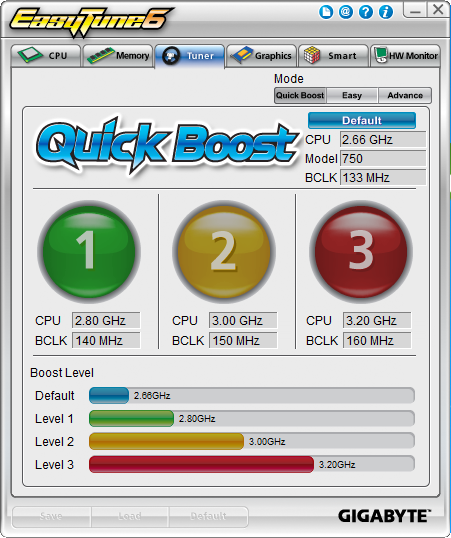
Quick Boost mode is a simple way for novice users to quickly overclock their systems without entering the BIOS. Once you click on one of the three boost levels, the utility will automatically optimize system settings according to your specific hardware combination. A reboot is required since this not an on-the-fly routine. The program is based on algorithms of hardware that has been pre-tested by GIGABYTE engineers unlike the MSI and ASUS offerings that evaluate your actual hardware configuration.
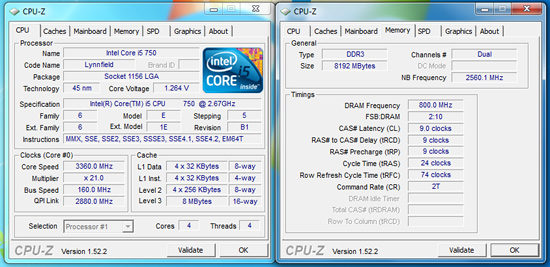
We tried around fifteen different hardware combinations and all worked correctly. Of course, it should work as the single core turbo mode on the i5/750 hits 3.2GHz without a problem, even when undervolting. Of course, with the Level 3 overclock, all four cores will be operating at 3.2GHz which comes in handy with video/audio encoding or 3D rendering programs. Although our memory kit was capable of C7 settings at DDR3-1600, at least this application set the board to DDR3-1600 speeds. Otherwise, the aggressive turbo modes on the Lynnfield processors have just about made this particular feature useless.
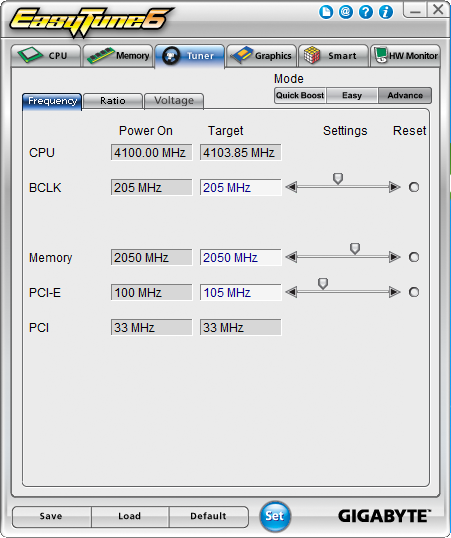
For those who appreciate and want a manual approach to overclocking, the Tuner tab has two different options. Easy mode allows control over Bclk, but it is Advance mode that opens several on-the-fly tweaking options that actually work. You can adjust Bclk, memory speed, PCI-E frequency, and numerous voltage options.
We have to say that using EasyTune6 was an almost painless experience although we prefer BIOS tuning on this platform. During the more extreme overclocking tests, this was the first application we loaded after getting the OS installation up and running. ET6 can be a huge help in tweaking those final settings to find a motherboard's overclocking limits.
DES 2
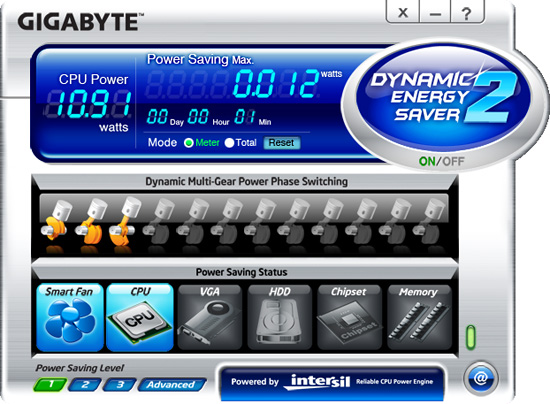
One of the most highly touted features from GIGABYTE is their Dynamic Energy Saver (DES 2) advanced power management solution. GIGABYTE provides a Windows-based software application to control DES 2. After installing the software (we highly recommend downloading the latest version) and a quick reboot, the application is ready for use. The control panel is powered down by default and it is up to the user to turn it on with a simple click of the DES button.
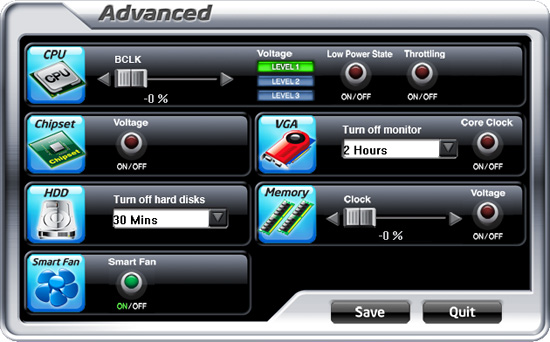
The DES software is simple to use and easy to understand. GIGABYTE provides a power savings meter in the top portion providing us with power savings information that can be reset at startup; otherwise it will track the power savings since the installation of the product. Real-time CPU power usage is available along with a graphic representation of the phases in use. You can also enable CPU throttling to save additional power during operation. The advanced tab lets you set power saving options for other peripherals, although we did not notice any additional power savings compared to Windows 7 default setup.
GIGABYTE also includes an onboard LED system that indicates the number of phases in use. These LEDs can be turned on and off from the control panel. The user can utilize DES while the system is overclocked although we typically did not measure any power savings in CPU bound applications, but games tended to respond well with a 3%~9% power savings.
Smart 6

Gigabyte also includes their new Smart6 software package that consists of Smart Quickboot, Smart Quickboost, Smart Recovery, Smart DualBIOS, Smart Recorder, and Smart Timelock. Smart Quickboot is a simple way to quickly set S3 sleep state in the BIOS and enable Hibernation in Windows. Smart Quickboost is the auto overclock application in ET6.
Smart Recovery is a method to quickly backup files or directories but not complete OS images. The unusual feature here is that even reformatting the drive will retain this hidden partition and data. We tried, it works. Smart DualBIOS is a personal recorder for saving important dates or password in the BIOS. Even if you lose this information in the OS, it is still retained. The downside is that reflashing the BIOS wipes the data clean. SmartRecorder is basically a time logging program to track access times and monitor file changes. Smart Timelock is a software application that can lockout a PC user for a certain period of time, but the time period considers a day to be only eight hours.
















55 Comments
View All Comments
goinginstyle - Monday, October 5, 2009 - link
I loved the review also and it showed a lot of work went into testing these boards. I just wonder when TA152H is going to ruin this thread but until then it nice to see constructive posts. I also wish the mobo guys would just drop the floppy and IDE ports when possible. It would free up board real estate and hopefully drop the cost a little more.papapapapapapapababy - Monday, October 5, 2009 - link
not touching any of this at least it has Socket 775 mounting holesusb3 @ pci3 @sata6 and im there.
Docket - Monday, October 5, 2009 - link
It is a shame that there are no Linux versions of the Gigabyte software reviewed here... oh well maybe some day in a distant future.mitt - Monday, October 5, 2009 - link
Hallelujah! DPC latency benchmark in AnandTech reviews!mathew7 - Monday, October 5, 2009 - link
When MB manufacturers are going to let go of PCI?I recently switched to Micro-ATX, and found I have a real problem of choosing a motherboard.
I'm looking at buying a PCIe X-Fi, but would like to use a dual-slotted video card. But I would like to keep my options open for a second card (I'm htinking about physics, not SLI/CF, so dual-slot cooling is not required). While the Gigabyte does not pass my requirements, the Asrock also has a problem: usage of a dual-slot-cooled card inhibits the usage of the PCIex1 slot.
I intend to switch to i5/P55 at the start of next year, so I'm watching closely.
Jaybus - Thursday, October 8, 2009 - link
That will be a slow transition. There are still a lot of PCI adapters being sold out there, especially for some specialty markets like scientific instrumentation that take time to transition to new interfaces due to cost and low volume. Nevertheless, the demise of PCI is starting to happen. For most people it's not a big deal, because they only need 1 or 2 PCIe x16 slots for graphics cards and will never use the rest of the slots anyway.MadMan007 - Monday, October 5, 2009 - link
Kind of funny but Intel is leading the pack in that specific area, their $200 (ugh) 'Extreme' DP55SB mATX P55 mobo has no PCI slots, also no PS/2, IDE or floppy. Maybe it's consistent since they ditched PS/2 and other legacy connectors on some boards a while back. No telling on the overclocking front but it is an 'extreme' board so it may have at elast some overclocking features. It has a couple of neat features actually, Bluetooth and Intel NIC.Jaybus - Thursday, October 8, 2009 - link
And uATX is a good platform to remove PCI from. Why not drop it from uATX? They can always leave it on ATX boards for a while for those who absolutely need PCI slots. I think other manufacturers will follow that path very soon.MadMan007 - Monday, October 5, 2009 - link
*bzzt* The only PCIe 2.0 lanes on a P55 platform are from the CPU. So look carefully at specs and double check with companies when they say their secondary slots, especially ones that aren't even 16x mechanical, are PCIe 2.0. The UD2's 4x electrical slot in particular is clearly not according to Gigabyte, the ASRock claims to be but I'm not sure how if all 16 CPU PCIe 2.0 lanes are used for the graphics slot. If they used a lane splitter to provide PCIe 2.0 lanes to the other slots it kind of defeats the purpose, and if so it would be good to check performance with those slots populated.MadMan007 - Monday, October 5, 2009 - link
To follow up on this, the comment was based on the first few paragraphs. I looked over Intel's manual for their 'extreme' mATX board for my post about it and Intel actually states their mobo has PCIe 2.0 lanes to the additional PCIe slots. Not surprising for the 8x slot I guess but it is for the 1x slots and it seems unlikely Intel would misquote specs.On a related note there is one thing I've not seen yet from any review and that is how PCIe lanes get assigned, mainly to the primary 16x slot, when populating a secondary PCIe slot with a 1x or 4x card. Do the lane splitter chips assign 8x lanes to a secondary slot which has a 1x or 4x card or what? Not a huge deal but it's a little thing that would be nice to know.